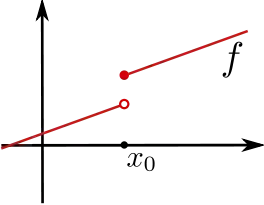How to prove that a strictly increasing function $f:[a, b]\rightarrow \mathbb{R}$ which has the intermediate value property is continuous on $[a, b]$.
4 Answers
Let $c$ be a point with $a<c<b$, and suppose given a small $\epsilon > 0$ (small enough that $c+\epsilon<d$ and otherwise arbitrarily small). Use the intermediate value property (and strict increasingness of $f$) to pick $d$ with $c<d<b$ for which $f(d)=f(c)+\epsilon.$ Since $f$ is strictly increasing, for all $x$ in $[c,d]$ we have $$f(c) \le f(x) \le f(d).$$ And $f(d)-f(c)=\epsilon.$ [Note: In the $\epsilon, \delta$ continuity definition, we have chosen $\epsilon$ first, and then found the point $d$, and are defining $\delta=d-c$.] This given "half" of continuity at $c$, and the left half is similar to show.
At either endpoint $a$ or $b$ we only need the above argument one way.
- 29,884
- 2
- 31
- 52
We have infact, more general result:
$f: \mathbb R \to \mathbb R$ strictly increasing and has IVP is continuous in $\mathbb R$.
Pf: If possible $f$ be not continuous in $\mathbb R$. So, there exists $c \in \mathbb R$ where $f$ is not continuous. So, there exists $\epsilon >0 ,\forall \delta>0$ with $|x-c|<\delta$ implies $|f(x)-f(c)|\ge \epsilon.$------(1).
Now as $f$ is strictly increasing $f(c-\delta)<f(c)$, Without loss of genarilty we may assume $l:=f(c-\delta)<f(c-\epsilon)$, Take a point $y_0 \in [f(c-\epsilon),f(c))$, for this $y_0$ there is $x_0\in [c-\delta,c)$ such that $f(x_0)=y_0$[IVP]. This contradicts (1)
- 355
Hint: Since $f$ is increasing, for every $c\in[a,b]$, $f(c^{\pm}):=\lim_{x\to c^\pm}f(x)$ exists, and it suffices to show that $f(c)=f(c^\pm)$, where for $c$=$a$(resp. $b$), only consider $c^+$(resp. $c^-$). If it is not the case, you may use the intermediate value property to derive a contradiction.
- 46,359
- 16,234
- 44
- 70
You cannot prove that because it is not true, there are functions that are not continuous that have this property. Just think of a function that is strictly increasing but with discontinuities and that is defined in the hole interval that you will notice that it can still obey the property.
- 917
-
The example you give doesn't satisfy the intermediate value theorem, as not all values of $f$ are not attainable in $[a,b]$. A better counter example is on the domain $[0,2]$ with the function $$f(x)=\begin{cases}x&0\leq x<1\2x&1\leq x\leq 2\end{cases}$$. – Daryl Nov 08 '12 at 19:57
-
1@Daryl Your function does not satisfy the IVP; since it takes the values $0$ and $2$, but not the value $1.5$. There is no counterexample ... – David Mitra Nov 08 '12 at 20:04
-
@DavidMitra I just realised I made a mistake when you replied. The second function should be $2(x-1)$ on $1\leq x\leq 2$. This maps every value from $[1,2]$ onto the range $[0,2]$. You can then choose an arbitrary function, satisfyiny the increasing property on $[0,1)$ and the piecewise function will satisfy the IVT. – Daryl Nov 08 '12 at 20:08
-
But since $g(x)=2(x-1)$ already covers $[0,2]$ and is strictly increasing there, the limit as $x \to 1^-$ of the first function must be $0$ in order to maintain that the piecewise function is strictly increasing and continuous. And (I think) that makes the function continuous at 1. – coffeemath Nov 09 '12 at 02:57